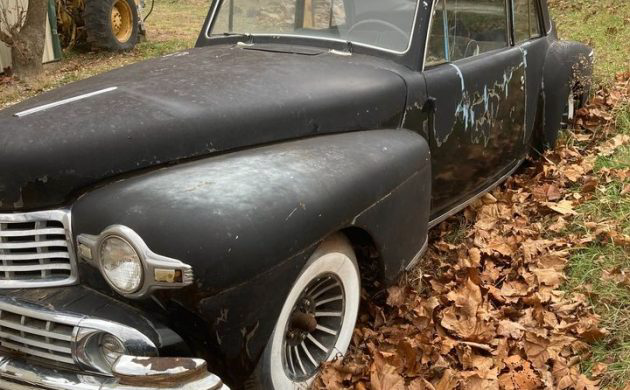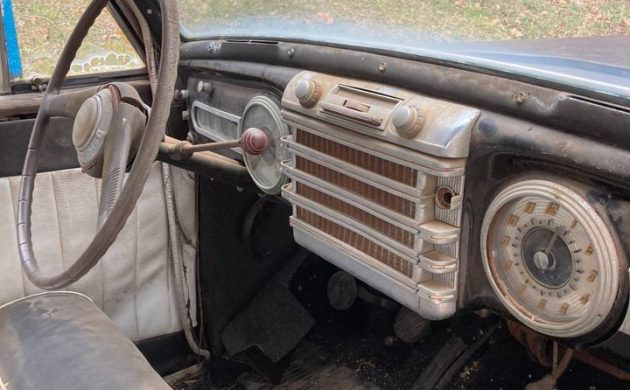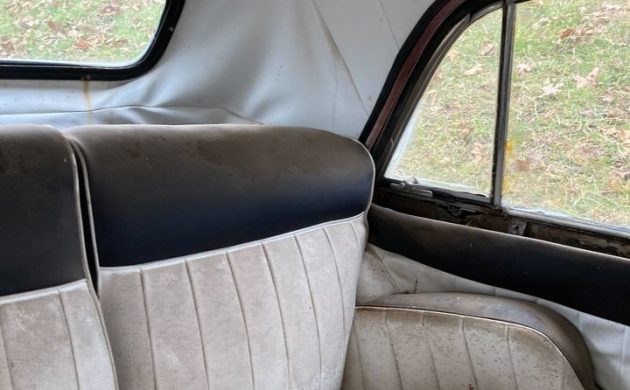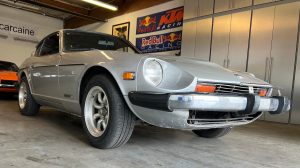When new, luxury cars live pampered lives. Their well-heeled owners lavish the finest care upon them, and they are almost always kept in stock condition. The inevitable fall down the used car ladder can be rough though. Sometimes that fall in value and condition can be quite humiliating. Intrepid reader T.J. has found for us a luxury car that almost needs to be rescued from its current situation. This 1947 Lincoln Continental for sale on Facebook Marketplace in Huntsville, Arkansas was once the finest vehicle in Lincoln’s upscale line. Now it slowly decomposes in a field on a set of turbine wheels shod with whitewall tires. Do you think this once fine automobile, complete with hydraulic window lifts, is worth saving with a $7,800 asking price?
In a nutshell, the first Continentals came about in kind of a strange way. Edsel Ford was a connoisseur of fine automobile styling and occasionally indulged in commissioning a beautiful body that was to be installed on a chassis made by the Ford Motor Company. In 1938, Edsel and Bob Gregorie, Ford’s unofficial chief automobile designer, sat down and came up with a sketch for a convertible using the Lincoln Zephyr convertible as a starting point.
Work got underway on the old, underutilized factory that the soon-to-be-discontinued Lincoln Ks were being built in. This factory was filled with skilled craftsmen who managed to complete the initial car and have it shipped down to Edsel’s home in the Palm Beach, Florida area in time for his family vacation. Palm Beach was one of the hot spots for the uber-rich to vacation back in the day and is still a very high-scale area. The car gathered an inordinate amount of attention from the swells. Edsel promptly called Gregorie and started to make plans to put the design into production.
What resulted was a car that created a sensation in America. Famous architect Frank Lloyd Wright declared that it was the most beautiful car ever built and would end up having two of them in his stable. Produced from 1939 through 1941, the original design with the Zephyr grille was a sales hit, relatively speaking, for Lincoln. The problem was that the styling would have to be updated along with the rest of the Zephyr line. How does one update a masterpiece?
The updated car that debuted in 1942 was pretty much unchanged from the cowl back. Forward of the cowl was another story. While stately and dignified, the front end didn’t mesh well with the rest of the car. Sales continued to be acceptable for such a vehicle. However, the first edition of the Continental still brings much more money than the second on the classic car market now. This has a direct effect on the number of Continentals with updated styling that end up restored. Also, factor in that when you are talking about a luxury car, restorations are more expensive. You can say that the more expensive than usual restoration isn’t about the money as long as it isn’t your money being sunk into the project. While there are many survivors with the updated styling, there just aren’t that many fully restored ones rolling around.
The 1947 Lincoln Continental you see here is a pretty standard example of the unrestored ones that pop up from time to time on these pages. Most are solid and restorable and often go for a reasonable sum. This one is no exception. Under the hood is the famous Lincoln V-12 of the Zephyr era. You would think that Ford would have based the engine on the standard Flathead of the time. For some reason, they based it on the smaller V8-60 block. This one is said to spin over freely. The picture above of the heads with the sparkplugs out suggests that the seller has been attempting to get the car running with no success. Hopefully, the cylinders were lubricated first. It is said that the car has a new gas tank. However, the glass bowl before the fuel pump suggests the gas hasn’t gotten to the engine yet.
The brakes also need some work after sitting for so long. Among the other items to get your wrenches wet on, the power windows are hydraulic and powered by a pump. My grandfather told stories of working on cars outfitted with these early systems. When a hose breaks, you will get one hard-to-clean-up flood of hydraulic fluid. Other than those issues, the car appears to be solid. Much of the chrome and stainless trim pieces are still good. However, the front bumper will need to be re-plated. That may set the new owner back the cost of a small house in a fashionable area at current rates. Inside we see that the radio is still there along with all of the trim. Unfortunately, the interior vinyl is showing signs of mold damage. Hopefully, that doesn’t mean that moisture has been trapped in the car. It makes you wonder what the floor pans look like.
This seems like it would make a nice car once restored. It could also be a great car for someone who is into touring and traveling with the various clubs out there. The engines on these tend to overheat if pushed. However, this car is equipped with overdrive and better radiators can be made by a few vendors. If you invest the time and money, this could be quite the car to enjoy. It just couldn’t be seen as a strong investment like the earlier Continentals. Hopefully, it will find a good home soon. When it does, I hope the first thing the new owner does is get rid of the turbine wheels.
Would you invest the money in a later edition of the first Continental? Do you like the front-end styling, or did Ford miss the mark on this one? Please share your thoughts in the comments.

















I wonder what that V12 sounds like when it’s running. The body from what I can see looks rock solid. I would be tempted to just get it running and retrim the interior and call it a day. Oh and get rid of the wheels for some period correct ones. Too bad it’s not a convertible too.
These definitely weren’t the best looking Lincolns. And this one’s been used and abused for quite some time. Pass.
If the motor runs it’s worth $7,500.
My guess is—soul crushingly expensive to restore but very cool once completed. Maybe Jeff Bezo would be interested in taking this project on.
The burbel of the V-12 is one of the sweetest sounds ever made by a domestic car. There was one that passed me every day on my walk to Jr High School, and, in my small collection of toy cars I had a red rubber one – the ’46 – ’48 model convertible. I also had a late ’40’s Buick in some sort of irridescent blue plastic that gave off vapors, where the front fender flowed all the way to the back fender. Now, these are BIG cars, they used Ford’s transverse leaf spring, just like the old wagons and carriages, they are pretty simple behind the sheet metal and interior trim. If you think the Cadillac Northstar engine is/was designed and built with inherit problems, it is bullet proof compared to this V12. Many were replaced with 50’s Caddy engines at the time, although the post war engines were improved over the pre war ones. If you have to ask, “which war”, you are a youngster. If I had a collection, and a wife and space are the obstacles, I would buy it, along with a ’41 Caddy 60 Special 4 door sedan. The two are the height of late ’30’s early 40’s styling, at least to me.
Yes, I’m aware of that V-12’s historical issues. Being based on Ford’s mid-’30s V-8, it inherited that engine’s overheating problems. But that wasn’t the worst of it. That series of engine went through 2 displacement changes from its original 267-cid incarnation: First to 292 around ’39-ish, then to 306 in ’42…and it was the latter that really did a number on Lincoln’s mechanical rep. The cylinder walls were bored out too thin, meaning that engine could self-destruct at any time. And then, there was the dreadful Liqua-Matic transmission option, which was so poor in operation that nearly all cars that were fitted with it were brought back to be refitted with the standard manual box (what few weren’t refitted probably ended up in scrap yards and made into ships and tanks for the war). Probably the only thing which spared Lincoln serious public embarrassment was the war truncating production for that year. The engineers thought they could keep with the 306 early on with the ’46 models until they learned about its fatal flaw, so they went back to the ’41 specs, of 292 cid and 120 horses. But they did make some changes in ’47 that added 5 more horses without the need for over-boring. I read that they wanted to keep 12-packs, but they just could not design one that was practical (maybe the K V12 could have served as a good test bed, but that engine design was already long gone). That was why they resorted to the 331-cid truck V-8 for the ’49 cars; it was a bit more durable, and it generated more power.
Where is that darn lottery ticket ? I like this style
There’s actually a major difference between the blocks of the Ford flathead V8s and the Lincoln V12. The V8s had a 90 degree cylinder bank angle. The V12 had a 75 degree.
People obviously had a very weird sense of beauty back then. The front end looks like the result of an argument – make it part of the bumper / make it the end of the cowl as it’s supposed to be — oh heck — we’ll just do both — result – Ugly – which they certainly didn’t forget how to do when they designed the Edsel. — The rear end is standard fare – except with a couple pieces of chrome added to the tiny penlight taillights, which never made any sense of cars of that era either. And then there’s the spare tire on the bumper blocking access to the trunk – so it had to have a little rectangle flip-door behind the rear window that created the same effect of bending over into a tall deep chest freezer — stupid! And the dash is standard fare for the time – so put a huge speaker grill below the radio in the center – yeah that’ll spruce it up – NOT — but hey – it’s got a huge clock – that probably never kept accurate time – while being larger than the speedometer and mismatched in style. And the seats have extra-thick padding that doesn’t age well and soon creates sagging upholstery that looks like a spare-tire cover. And then there’s the utter-ridiculous hydraulic windows – a nightmare just waiting to happen – that any mechanic could tell them – well before going into production. – I guess they hadn’t figured out vacuum-assist for such things yet – and with that big V12 engine, I would think there would be plenty of vacuum for such use – or how to use little electric servo-motors for such use either. — Unless someone just wants it to complete their collection of old ugly ridiculously designed cars – I don’t know why anyone would put down the money they’re asking for it. — Big Pass!
Al Dee,
I’m not aware of any production automobile using vacuum to raise & lower windows. Vacuum WAS briefly tried to raise & lower convertible tops, but the cylinders were very large, and just didn’t have the power needed. GM used them in 1940-41, Ford in 1940, but I don’t think Chrysler ever tried vacuum power tops.
The vacuum power top on my 1941 Cadillac convertible coupe was very trouble prone, and it took forever to even begin raising the top, hence I replaced it with Hydraulics. With vacuum, it has to remove atmosphere in a slow process to achieve maximum power, while the hydraulics is basically instantaneous.
Most cars using vacuum top systems were converted to Hydraulics.
As for electric motor use for windows, it wasn’t until the mid 1950s that 2 things happened to make the switch to electrics happen; 1] Cars switched to 12 volts. 2] Delco began making more powerful [and small] 12v DC motors capable of raising & lowering heavy window assemblies, especially on 2-door cars. Doubling of the DC voltage lessened the amount of power [amperage] required to do the same job.
I owned a 1950s Mercedes sedan with a Bosch electric power division window motor, and that 6v motor was the size of a half-gallon milk container.
Vacuum assist was used by Ford / Mercury for many things in their autos for a long time. My ’76 Mercury Marquis Brougham had multiple vacuum assist operations. The headlights doors opened and closed using vacuum. All of the dash operations – opening and closing vents to direct the airflow was all vacuum-assist. They used electric DC servo motors for the electric windows and driver seat adjustments. Using vacuum assist to operate heavy objects – like a convertible roof and huge pieces of glass in 2-door full size cars would not be a good use for that. Convertible roofs were all manual on cars designed by those that were well aware of the problem of hydraulics in a machine where the hydraulic lines had to be hidden away in inaccessible areas of the machine – like a car but worked well on bulldozers and such where the lines were easily accessible and fully visible for any signs of leaks. Six volt electric motors work just as well as 12v motors – you just have to have a more robust battery and generator is all that is required. The bottom line is: hydraulic lines hidden away inside the body of a car always was a terrible idea – as hydraulic fluid is very corrosive to steel, Doing it anyway is simply a manufacturers disregard for the maintenance and life of the vehicle – only sales volume matters – and after that – it’s the owner’s problem – as it was for most manufacturers until the Japanese came to town with sensibly designed vehicles made to last much longer than anything America was putting out – and that cooked their goose as it should have – but it was nothing that American companies couldn’t have done as well — if they only cared about the customer as much as they did their bottom line.
Rick,
You are correct. Many people think this motor was simply a Ford V8 with 4 added cylinders, while the truth is that very few parts actually interchange. NOS and replica parts are available, but starting to get scarce. There are 2 major parts sources for the ‘H’ series Lincoln V-12 cars ’36 to ’48; Boos-Herrel, and Vintage Auto Garage. There was another parts source in Frederick, MD that I used for the older Lincolns and Mercedes-Benz cars, but I think the guy has passed away
Jeff; The windows & seat are hydraulic, but don’t use regular [petroleum based] hydraulic fluid. They use DOT 3 brake fluid. This presents 2 possible problems; 1] when the cylinders leak or a line develops a rust hole, and still has the brake fluid inside, brake fluid is well-known for quickly removing old lacquer paint. 2] if someone has mistakenly added regular hydraulic fluid to the hydraulic pump container, ALL the cylinders & flex rubber lines MUST be replaced, and the entire hydraulic pump will need overhaul.
Basically the entire window & seat hydraulic system will need replacement/rebuilding. The new owner should buy the reproduction cylinders and flex lines, plus the pump kit, all set up for modern automatic transmission fluid [ATF], it’s a ‘No Brainer’.
Note that all American cars of the 1940s and 50s with hydraulic windows employ a system that used the fluid to raise the windows AND KEEP THEM RAISED, and use a powerful spring to lower the windows when a solenoid on the cylinder is given 12V. This means that over extended periods of time, no matter how good the solenoids on the cylinders are, the windows will slowly drop. I used to install small rubber wedges between the bottom of the glass and the door frame, to help keep the windows closed.
While getting the car running again, also consider having a new radiator made, as the original probably won’t provide the cooling capacity this motor needs, especially if you live in warmer areas or will use the car in parades.
Value/price? Unless the engine is running well, and there is no serious rust in the body panels, I suspect the owner is going to have a hard time finding a buyer at the asking price.
ok But Al Dee tell us how you really feel about the zephyr
lol way to much money but a very cool car
Cool car? OMG — What exactly is “cool” about it???!!!
My my, somebody got up on the wrong side of the bed
My brother had one of these back in the 60s. It had a Cadillac V8 in place of the V12. Also it had an interior similar to this one only the pleats were more rolled than these appear to be.
Wherever we went it was the hit on the street. Few people had any idea what it was and we had great fun in it.
1947-48 Lincolns did have a Fugly front grill, definitely not as sexy as the earlier, Lincoln Zephyr designs. The engine turning freely is good news and the body looks very solid for the asking price. My eyes are still burning from looking at those turbine rims on this Lincoln, so someone please buy it and replace them.
I owned a 1947 Lincoln. It was available in Phoenix where I live, was is great cosmetic condition, and was a head turner. However, the 1947 front end does not hold a candle to the beautiful 1941.
The car was hard to drive, and stop. Manual steering was a pain, and the brakes, even set up perfectly, were inadequate when a kid in a Honda cuts you off as begin your slow down for a red light 1/4 ahead.
The engine was a joy, but mine like many others had heating / overheating issues. Sold it at Barrett Jackson and learned the lesson that not a lot of 80-90 year old buyers for these cars.
Mine had hydraulic window which I believe were factory installed.
I would say it is worth saving. Considering the current depression’s inflation effects, the going price isn’t that bad. If the structure is intact, a committed Lincoln collector could revive it.
I can imagine, as the author suggested, the nightmare of fixing a hydraulic accessory like the power windows; likely why the high-end marques resorted to electric alternatives as soon as they could. Oddly, Mercedes stuck with hydraulic-powered accessories well into the ’60s, with its Model 600; virtually everything except the radio and the ignition was hydraulic…and critics of the day praised them for it. I’m sure those critics never experienced a blown hydraulic line, however; or if they did, never expected Germany’s finest to ever have such issues. The second law of thermodynamics dictates that this is inevitable without exception…and as we know from history, when German cars do break down, they break down HARD. New fabricated hydraulics can fix the windows of this car, I think.
Cars like these need to be preserved when even remotely possible. Considering that the first-gen Continental was one of only two cars ever accepted by the New York Metropolitan Museum of Art as a work of art (the Cord 810 being the other), every example of these that can be spared needs to be…whether you prefer the coffin-nose look or the earlier twin-waterfall look.
The body looks pretty solid for its asking price. 1947-48 Lincolns had a fugly front grill, compared to the earlier Zephyr designs IMO. Great that the engine turns freely. My eyes are still burning looking at those terrible, turbine rims, someone please buy and save this Lincoln.
Edsel Ford, the driving force behind the beautiful ’39-’41 Continental, died in 1943 after a long battle with stomach cancer. They put the old man, who never cared for luxury cars, back in charge for a couple of years. My guess is that the Lincoln division was rudderless during the War which led to the fugly ’42-’48 Continentals. Besides Edsel was in charge of cranking out one B-24 every hour at Willow Run; he probably didn’t have time to pay attention to automobile styling.
I read Barn Finds daily for the automotive history education, and the period-correct prose.
“Swells” seems spot on for the time and place.
I remember watching a Lenos garage episode a few years back with him describing the hydraulic window, and door lock system in his Mercedes 600. He had his mechanics go thru it for adjustments, but they didn’t have to overhaul it entirely. I believe the Benz was a late 60s or early 70s model. So yes, Mercedes used hydraulic systems in its car for many years.